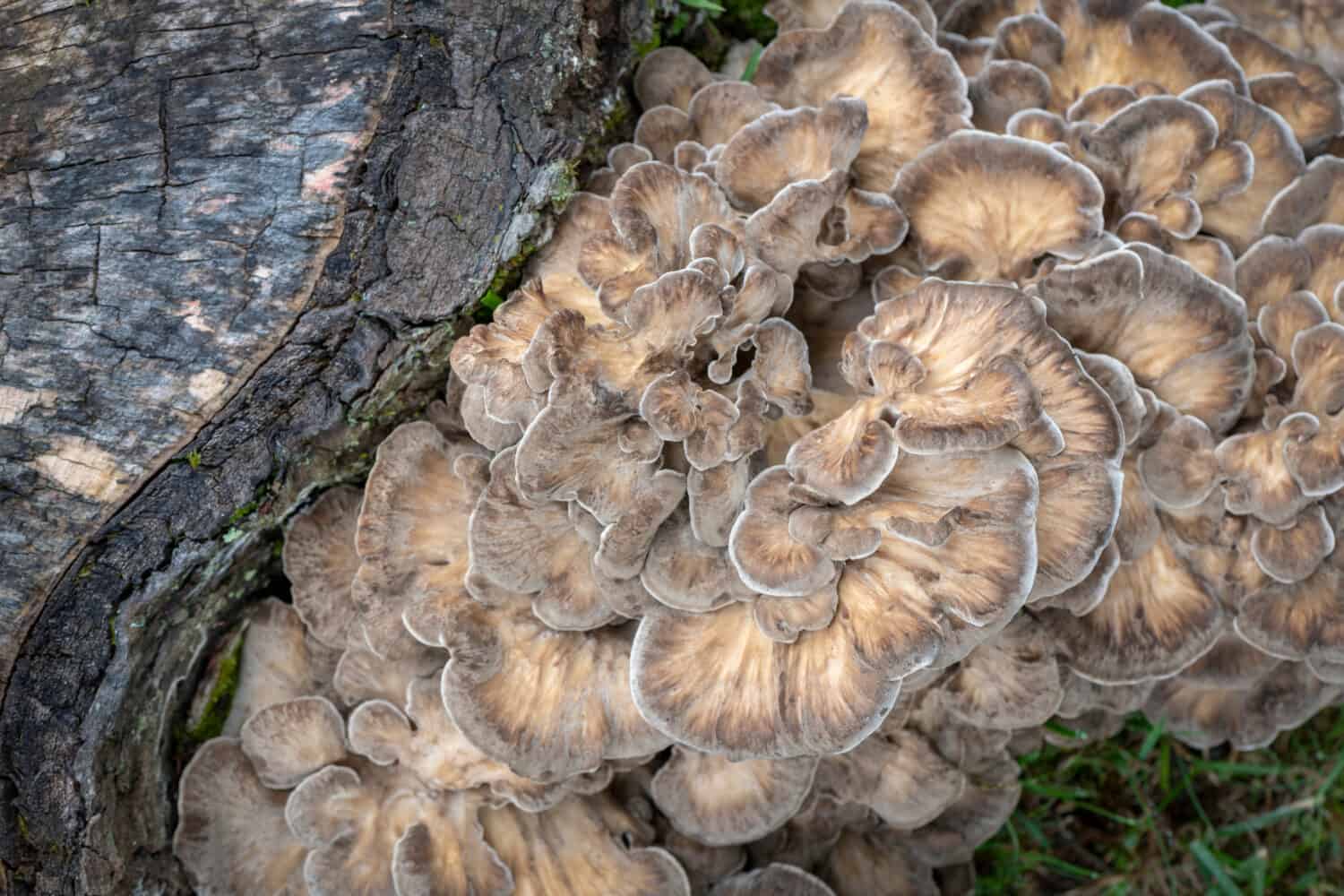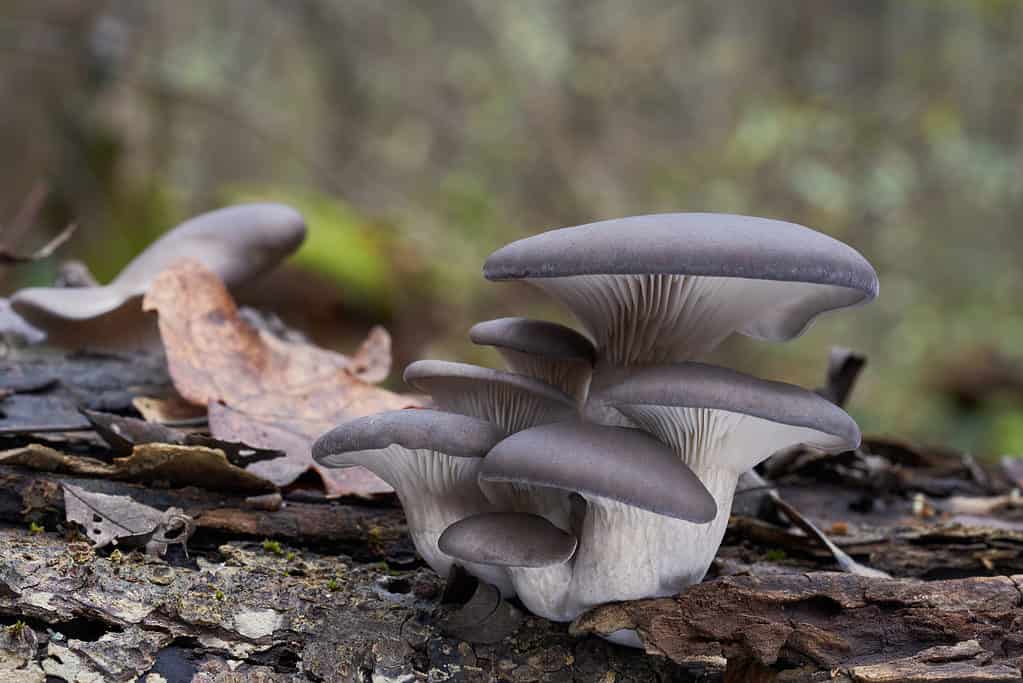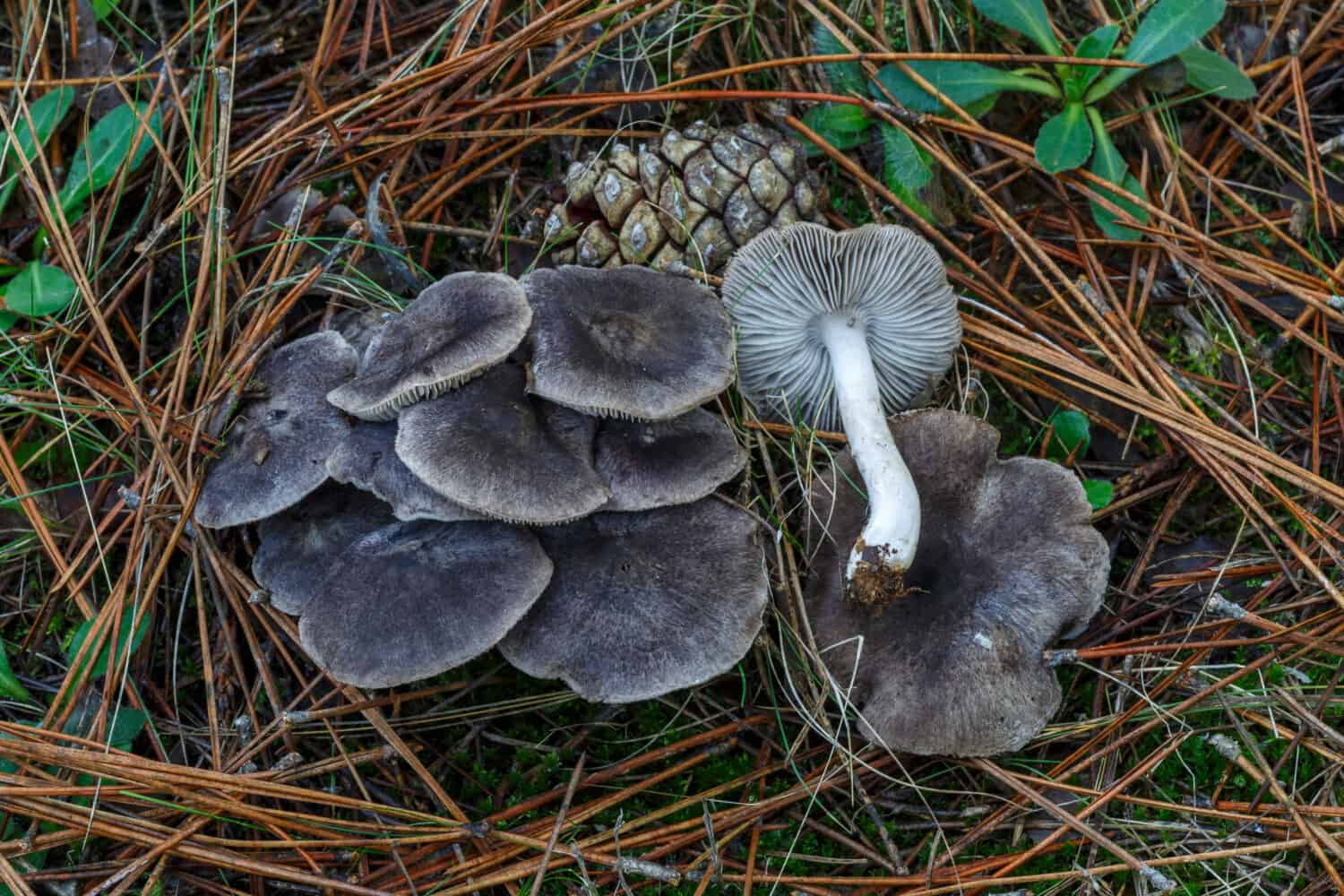If you enjoy noting the colors of mushrooms that you come across, you may have noticed that some species display various shades of gray and gray-brown. In fact, one of the most widely cultivated mushrooms in the world can display gray caps.
So, what mushrooms feature gray shades? In this guide, we’ll delve into three mushroom species whose color ranges include gray. We’ll cover their taxonomical classification, cultivation status, distribution, ecological roles, and some identifying features.
Read on to learn more.
3 Types of Gray Mushrooms Found in North America
Below, we’ll look at the following three species of mushrooms that occur in North America and other regions of the world:
- Hen of the woods (Grifola frondosa)
- Common oyster mushroom (Pleurotus ostreatus)
- The grey knight (Tricholoma terreum)
All three of these mushrooms are considered edible and two of them are commonly cultivated. However, whenever you forage for wild mushrooms, it’s crucial to be 100% sure of the identification before consuming and to know of any possible toxic lookalikes in your region. If you are new to mushroom hunting and identification, it’s best to go on forays with a mycological club or accompany a mushroom expert or mycologist. You can also send samples off to a lab or look to reputable identification groups and forums to assist with ID.
3 Types of Gray Mushrooms: Hen of the Woods (Grifola frondosa)

, aka “hen of the woods” or “miatake”.
©Brandt Bolding/Shutterstock.com
An excellent choice edible, hen of the woods (Grifola frondosa), also known as maitake, is a polypore mushroom of the Meripilaceae family. This mushroom is quite popular to forage and cultivate due to its choice edible status and claims regarding medicinal uses.
Distribution
Hen of the woods occurs widely east, and less commonly west, of the Rocky Mountains in North America. This mushroom also occurs in temperate forests of Europe and Asia. Phylogenetic research may result in classifying the Asian, European, and North American populations of Grifola frondosa as separate species. But for now, they remain classified under the one species name.
Ecology
This polypore mushroom grows at the base of living oaks and other hardwood trees where it is weakly parasitic, causing a white butt rot of the tree. Hen of the woods is also saprobic on decaying hardwood, meaning it can derive its nutrients parasitically from living trees and from dead organic matter.
As a parasitic and saprobic fungus, Grifola frondosa helps contribute to the overall vitality of healthy, ecologically diverse, and balanced forests in a few ways. Through parasitism of weakened trees, this fungus supports life forms that seek out dead and dying trees as habitat and food sources. It also supports the ability of the forest to maintain its vitality long-term by making room for new, healthy growth. As a saprobe, Grifola frondosa contributes to vital nutrient cycling.
Identification
If you live in this mushroom’s native ranges, you’ll want to forage in the late summer and fall in hardwood forests. Keep an eye out especially at the base of oak trees as oaks are a preferred host for hen of the woods. You may find this mushroom under oaks in urban settings as well, but always take note of any possible pesticides being sprayed or other toxins.
The fruiting body typically occurs in dense clusters. The caps are wavy along the margins and fan-shaped. The cap colors tend to range from lavender-grey to pale yellow-brown and light brown-grey. Individual cap width is 1-5 inches. The entire cluster has an overall rosette shape and can grow up to 36 inches across.
Underneath the caps, you’ll notice almost tooth-like pores that are arranged at an angle. The density of pores is about 1-3 pores per mm. The tubes of the pores are typically 1-3 mm deep. These pores run down the stem (aka stipe) often almost reaching the base of the mushroom. They appear off-white to lavender-grey in color and their spore print is white.
Three Types of Gray Mushrooms: Common Oyster Mushroom (Pleurotus ostreatus)

aka “oyster mushrooms”.
©iStock.com/Igor Kramar
Another favorite of foragers and cultivators alike, the common oyster mushroom (Pleurotus ostreatus) is a gilled bracket fungus in the Pleurotaceae family. This mushroom is currently one of the most widely cultivated in the world, favored for its mild flavor, meaty texture, and ease of cultivation.
Distribution
Pleurotus ostreatus occurs widely throughout temperate Asia, North America, and Europe. Cold and warm varieties of this mushroom occur, resulting in year-round fruiting in much of its range.
Ecology
The common oyster mushroom is primarily saprobic, deriving the bulk of its nutrients from dead organic matter. Specifically, Pleurotus ostreatus grows mostly on dead hardwood, although occasionally you can find it growing on conifer deadwood as well. This mushroom can also less commonly be weakly parasitic, causing a white butt rot, mostly on living hardwood trees.
Finally, Pleurotus ostreatus is a predator of nematodes. Fragile structures called toxocysts exist on the hyphae of P. ostreatus. These toxocysts release powerful toxins upon contact with the nematode prey that rapidly paralyze it, allowing the fungus to inject its filaments into the nematode and essentially suck up the nutrients.
Identification
While the common oyster mushroom occurs widely across its range and is an excellent species to forage, it does have potentially toxic lookalikes, so knowing how to ID this species is crucial. Check out our article on angel wing mushrooms (Pleurocybella porrigens) to learn about P. ostreatus’s possibly toxic lookalike.
Pleurotus ostreatus typically grows in shelf-like clusters. The fan or kidney-shaped caps range in color from creamy off-white, grey, grey-brown, and brown. The width of the caps ranges from 1-6 inches across. When young, the caps are typically convex. As they mature, they expand outward like a domed disc.
The stipe is nearly non existent or rudimentary. The gills of P. ostreatus are white to grayish, arranged closely, and run down the entire underside of the cap. The flesh is thick, almost rubbery, and does not change color when sliced. The spore print is white to very pale lilac-grey.
3 Types of Gray Mushrooms: The Grey Knight (Tricholoma terreum)

A beautiful collection of
Tricholoma terreumaka the “grey knight mushroom”.
©LFRabanedo/Shutterstock.com
The grey knight (Tricholoma terreum) is an edible grey-capped, gilled mushroom belonging to the Tricholomataceae family. While some people readily forage this mushroom, it is not currently cultivated due to the complex ecological relationships required for fruiting.
Distribution
Tricholoma terreum is distributed across Europe and North America. There is some question as to whether the populations of each continent are distinct from one another. Current North American synonyms for this species include Tricholoma gausapatum and, more commonly, Tricholoma myomyces. Some have separated these populations based on the presence or absence of a cortine-like veil. However, European research supports that the presence of this veil is inconsistent and does not necessarily suggest distinct species.
Ecology
The grey knight mushroom is mycorrhizal, meaning it derives its nutrients from a mutually beneficial plant-fungi nutrient exchange. This exchange takes place between the roots of the plant and the mycelium of the fungus. This plant-fungi partnership is quite complex, and overwhelmingly, mycologists studying the question of growing mycorrhizal mushrooms have not yet determined how to support cultivation.
Specifically, Tricholoma terreum is mycorrhizal with conifers, especially with pines. You can also find it growing with Douglas fir, spruce, and other fir species. Very occasionally, some populations of T. terreum have been found growing in association with hardwoods. This mushroom can grow alone, scattered, or in abundant numbers from spring through fall.
Identification
To search for Tricholoma terreum, you’ll want to look along the forest floor near the tree species with which they associate.
As the common name suggests, this mushroom features a gray cap. The caps are 1.5-3 inches across. When young, the cap is convex with a distinct, central bump. As it matures, the cap becomes broadly bell-shaped to disc-shaped. The cap is typically dry, or, when mature, finely scaley. The margins of the caps can be finely woolly in young specimens.
The photo featured at the top of this post is © LFRabanedo/Shutterstock.com
The information presented on or through the Website is made available solely for general informational purposes. We do not warrant the accuracy, completeness, or usefulness of this information. Any reliance you place on such information is strictly at your own risk. We disclaim all liability and responsibility arising from any reliance placed on such materials by you or any other visitor to the Website, or by anyone who may be informed of any of its contents. None of the statements or claims on the Website should be taken as medical advice, health advice, or as confirmation that a plant, fungus, or other item is safe for consumption or will provide any health benefits. Anyone considering the health benefits of particular plant, fungus, or other item should first consult with a doctor or other medical professional. The statements made within this Website have not been evaluated by the Food and Drug Administration. These statements are not intended to diagnose, treat, cure or prevent any disease.
Thank you for reading! Have some feedback for us? Contact the AZ Animals editorial team.







